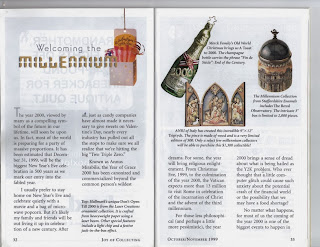First, the banner. I don't know who did that panorama of Times Square or where I got it from, so whoever made it, I thank you for an absolutely beautiful image! Let's give a big hand to whoever made that picture!
Second, the first official New Year's custom logo.
Third, I'd like to turn back the hands of time before the clock chimes midnight, and ring in a new tradition that I like to call "The Millennium Museum's Personal Best."
Ready? Buckle up, 'cause here we go!
DECEMBER 22nd, 2012:
The Millennium Museum opens. The first Item displayed is a
Year 2000 face-towel. The original
DECEMBER 31st, 2012:
The Museum’s first New Year’s Eve; the next Items are Doctor
Who: The Movie
and a Danbury Mint Millennium Baby.
JANUARY 1, 2013: The Museum unveils its logo!
FEBRUARY 4: The “On This Day”
feature debuts. I admit with some shame that it has fallen by the wayside because it got too hard to do without a handy articles database. (I'm taking a class at Moraine Valley in the new year, so with that I should get access to the news databases.)
MARCH 17: St. Patrick’s Day
inspires the creation of a prototype “custom logo.” In this case, the banner’s
usual silver gradient changed to the colors of the Irish flag. Little else
changed, but the seed of an idea was born.
APRIL 3: In the real world, the
Museum’s curator gets a job!
MAY 5: Series 2 begins! The first item seen is a
collection of state quarters, which were part of America’s Millennium
celebration.
MAY 19: The Museum hosts its first-ever video review. It’s pretty embarrassing, but
you’ll see a few more of these in the years to come.
SEPTEMBER 11: This issue, a
Special Edition, is the game-changer. Here, we learn what all of my
previous postings had been leading up to.
SEPTEMBER 29: This issue marked
the first time I drew something special for the Museum since the logo.
It was a background of fall leaves blowing in the wind.
OCTOBER 13: The “Jack-O-Lantern”
variant makes its debut. Also, we look back at The Blair Witch Project.
NOVEMBER 23/24: Doctor Who celebrates its 50th
anniversary, and the Museum responds by commemorating the first-ever Chicago TARDIS
convention.
DECEMBER 22, 2013: The Museum celebrates its first
anniversary! The
week before sees the Museum’s first-ever Christmas celebration—I didn’t mark
the occasion the year before because I just
didn’t think of it.
DECEMBER 31, 2013:
And now, ladies and gentlemen, the moment you've been waiting for...the last two Millennium Items before we leave 2013 behind.
I found this in
a St. Vincent de Paul Thrift Store out in Midlothian, IL. (My work sometimes
takes me out there.) This cassette tape came out in 1999, and the publisher is
listed as K-Tel International.
K-Tel is
well-known for producing compilation and “greatest-hits” albums that are mostly
sold on late-night TV infomercials. Most of the time, their records are the
original recordings, but sometimes they use original recordings: this tape’s
songs are performed by the Tony Burgos Orchestra.
There are at
least two Louis Prima standards (“Jump, Jive, an’ Wail” and “That Old Black
Magic”); Hoagy Carmichael’s “In the Mood” (later appropriated by Benny
Goodman); as well as many other songs from the big-band era.
The collection
of old, mostly public-domain songs more than fulfills the “preserving history”
credit, but the new recordings add a new wrinkle to that: It breathes new life
into the tunes of yesterday. I can’t think of a better way to ring in a new
year than this.
A quick browse through Microsoft Word’s clip-art gallery for some New Year’s fireworks, for something else I had in mind, yielded
these four examples from the Year 2000. It’s amazing that they still have all
that old clip art in their archives. There's honestly not much to summarize here; I'm just surprised to have found it! Still, it's one for the books.
When I first opened the Museum, my first rule was “don’t just
use pictures from the Internet.” The rationale at the time was, simply using
pictures found on the Internet would defeat the purpose of hunting for items.
As time has rolled on, I’ve since discarded the rule, mostly because time and
money are never on my side. Also, Millennium Items are getting harder and
harder to find in the real world; the one-month “season hiatus” is also not
enough time to go looking. I may expand this to two months in the new year…something
to think about.
Anyway, case in point: I found this picture of a Times Square
puzzle on eBay. It’s a stunningly realistic painting of a Times Square
panorama. Besides all the true-to-life billboards and advertisements, there are
messages beckoning you to “Welcome A New Century!”
It perfectly captures the exuberant, triumphant mood of the
New Millennium celebrations—Times Square has been the mecca for New Year’s
celebrations for as long as I can remember, definitely even longer!
I do remember that there was a Show Boat revival (“Ooooool’ maaaaaan riveeeeeeer…”) at the time,
so the big billboard is accurate. Can’t remember if the Broadway revival and
the tour revival went along at the same time, or if there was a gap in between,
but I do remember the TV advertisements for the “Broadway in Chicago” version.
The “…money America is saving with MCI” billboard dates it a
little bit, because MCI/Worldcom suffered some kind of a scandal back in 2002
or so, which led to MCI’s bankruptcy.
Somewhat inexplicably, the Tin Soldier balloons are being
pulled by a teddy bear and a white rabbit (blow up the image and take a look at
the lower right part of the image).
There’s also a very big ad for “Bloomberg Information Radio.”
That’s kind of funny, because Michael Bloomberg has been the mayor of New York
City from 2001 until this year, when he will be replaced by Bill de Blasio.































